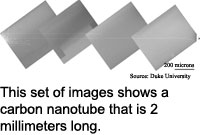
Nanotubes smash length record
Duke University researchers have found a way
to make especially long, well-aligned carbon nanotubes. Nanotubes, which
are rolled-up, single-atom-thick sheets of carbon, have great potential
as components of nanomachines and nanoelectronics.
The researchers' method produces nanotubes as long as two millimeters,
which is 100 times longer than previous efforts, according to the researchers.
The nanotubes were 2.5 nanometers in diameter, or about the length of a
row of 25 hydrogen atoms. A nanometer is one millionth of a millimeter.
The key to making the straight, long nanotubes is a hot flow of
carbon monoxide and hydrogen gases. The researchers used tiny clusters of
iron and molybdenum positioned on a small rectangle of silicon as a catalyst;
the long nanotubes formed in the direction of the gas flow.
The researchers also reoriented the gas flow to make cross-connecting
grids of nanotubes. Such patterns of tubes could form the basic building
blocks of nanoscale circuitry. The nanotubes' length make them easier to
handle; a single tube could even form several electronic components.
The technique should be perfected in two to five years, according
to the researchers. The work appeared in the April 22, 2003 issue of the
Journal of American Chemical Society.
Hydrogen storage eased
Flexible display slims down
Simulated evolution gets complex
Model explains market movements
News briefs:
Big qubits linked over distance
Software maps group work
Magnesium batteries show mettle
Nanotubes smash length record
DNA sensor changes color
Sensor serves up body slices

Research Watch blog
View from the High Ground Q&A
How It Works
RSS Feeds:
News
Ad links:
Buy an ad link
Ad links: Clear History
Buy an ad link
|
TRN
Newswire and Headline Feeds for Web sites
|
© Copyright Technology Research News, LLC 2000-2010. All rights reserved.